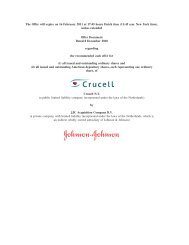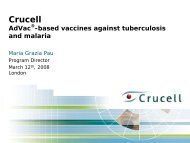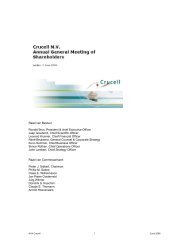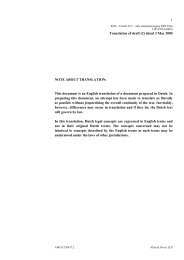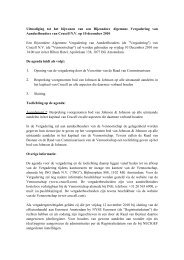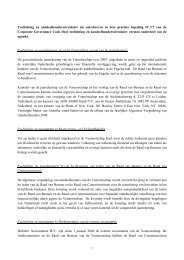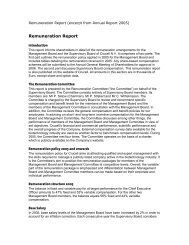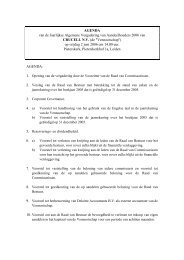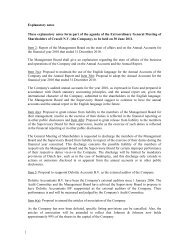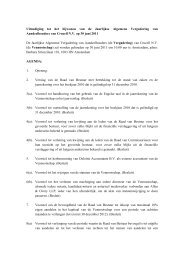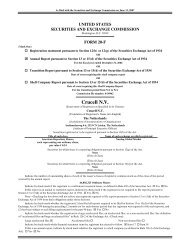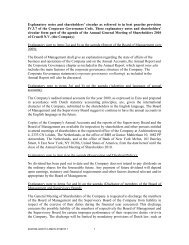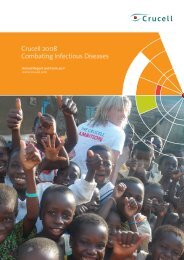Crucell corporate brochure (PDF)
Crucell corporate brochure (PDF)
Crucell corporate brochure (PDF)
Create successful ePaper yourself
Turn your PDF publications into a flip-book with our unique Google optimized e-Paper software.
<strong>Crucell</strong>’s commitment to the world – Taking responsibility<br />
R&D progress<br />
<strong>Crucell</strong> invested heavily in the advancement and expansion of pipeline<br />
programs in 2010. In line with our guidance to the financial market,<br />
R&D expenses increased by more than a third to €100.0 million,<br />
compared to €70.2 million in 2009. The rise was predominantly due<br />
to an increase in clinical development spending, reflecting progress<br />
in clinical trials and significant investments in our in-house product<br />
development capabilities.<br />
Development of our pipeline during 2010 was accelerated by a strategic<br />
collaboration with Johnson & Johnson, signed in September 2009. Under<br />
the terms of this agreement, Johnson & Johnson will finance a significant<br />
part of <strong>Crucell</strong>’s existing R&D program aimed at discovery, development<br />
and commercialization of a monoclonal antibody product for the universal<br />
prevention and treatment of influenza. This program is based on <strong>Crucell</strong>’s<br />
discovery of a new class of antibodies with the unprecedented ability<br />
to neutralize a broad range of influenza virus strains.<br />
The strategic collaboration also provided funding for four new discovery<br />
programs in areas where <strong>Crucell</strong>’s innovative science and technologies<br />
show significant potential to make an important difference to global<br />
health. One of these was specified at the time the agreement was<br />
signed, and two others were decided jointly by the collaboration<br />
partners on the basis of exploratory work by <strong>Crucell</strong>’s Innovation<br />
& Discovery Laboratory (I&DL) teams in the course of 2010.<br />
In the first of the new discovery programs, <strong>Crucell</strong> scientists are using<br />
the knowledge generated in our flu antibodies program to design<br />
a vaccine with the potential to provide lifelong protection against<br />
influenza, regardless of the causal virus strain. A universal flu vaccine<br />
would eliminate the need to formulate new flu vaccines year after year,<br />
and would at last provide a defense against a lethal new influenza<br />
virus with pandemic potential. Work started on this exciting project<br />
at the beginning of 2010.<br />
The second discovery program, launched in June, focuses on the design<br />
of a vaccine to prevent severe respiratory infections caused by all of the<br />
most common strains of respiratory syncytial virus (RSV). Infants and<br />
the elderly are especially vulnerable to life-threatening illness caused<br />
by RSV, which currently claims an estimated 160,000 lives annually.<br />
RSV-induced disease is the last major childhood illness for which no<br />
preventive vaccine is available.<br />
The third new discovery program, announced in November, targets the<br />
development and commercialization of a therapeutic vaccine against<br />
human papillomavirus (HPV). Around 250,000 men and women with<br />
chronic HPV infection die each year.<br />
Another R&D highlight during 2010 was the launch of <strong>Crucell</strong>’s in-house<br />
FluCell program: a new frontier for seasonal influenza vaccines. Inflexal®<br />
V, our current flu vaccine, is both highly effective and very well tolerated<br />
thanks to its underlying virosomal technology. Now we are working<br />
to combine this innovative approach to vaccine design with our highdensity<br />
PER.C6® cell–based production system. This will enable us<br />
to manufacture unlimited supplies of high-quality flu vaccine more<br />
efficiently, more cost-effectively and starting earlier in the flu season.<br />
The traditional production method grows the viruses used for flu vaccines<br />
in chicken eggs—a slow and laborious method that does not lend itself<br />
to high-volume manufacturing, as we saw during the recent pandemic.<br />
The fact that we now have three influenza programs in the pipeline<br />
illustrates <strong>Crucell</strong>’s approach to innovation. We seize opportunities<br />
to make a difference in the near future while simultaneously working<br />
towards breakthrough products that will take considerably longer<br />
to develop, test and bring to market.<br />
Investigational vaccines we already have in clinical trials made<br />
important progress during 2010. For example, in May the recombinant<br />
malaria vaccine <strong>Crucell</strong> is developing in collaboration with the US<br />
National Institute of Allergy and Infectious Diseases entered a new<br />
phase I trial in Burkina Faso, Africa. This is the first trial of the vaccine<br />
in a population living in an area where malaria is endemic. In October,<br />
we were delighted to announce the start of a new phase II clinical trial<br />
of the tuberculosis vaccine we are developing together with the Aeras<br />
Global TB Vaccine Foundation. The trial will evaluate the safety and<br />
efficacy of this promising vaccine candidate in infants previously<br />
immunized with Bacille Calmette Guérin (BCG) vaccine. BCG is the<br />
only available TB vaccine, but has very limited efficacy.<br />
43



